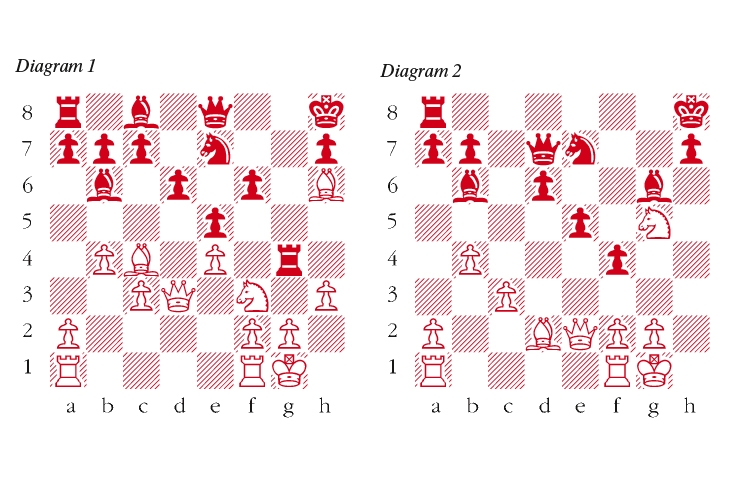One of the sharpest lines in the Ruy Lopez (1 e4 e5 2 Nf3 Nc6 3 Bb5 f5) is widely attributed to Wilhelm Karl Adolf Schliemann (1817-1872), said to be a relative of the Heinrich Schliemann (1822-1890) who discovered the site of Troy. Now it appears that the variation should in fact be attributed to Carl Jaenisch (1813-1872) since W.K.A.S. in fact advocated something rather different, namely 1 e4 e5 2 Nf3 Nc6 3 Bb5 Bc5 4 c3 f5. However as Junior Tay, author of the new book The Schliemann: Move by Move (Everyman Chess) points out, the name of Schliemann has stuck and it would take a lot of literary hard labour to undo the misattribution.
This week, a game and puzzle from the book, featuring a line which, prima facie, looks suspicious, but which in fact is remarkably vital and indeed viable.
Warman-Gareev: London 2016; Ruy Lopez
1 e4 e5 2 Nf3 Nc6 3 Bb5 f5 4 d3 fxe4 5 dxe4 Nf6 6 0-0 Bc5 7 Nc3 d6 8 Bg5 0-0 9 Nd5 Kh8 10 c3 Denying Black the use of the d4-square and preparing to advance the b- and a-pawns to harass the c5-bishop. 10 … Ne7 11 Nxf6 gxf6 12 Bh6 Removing Black’s strong bishop with 12 Be3 Bxe3 13 fxe3 is a logical alternative. 12 … Rg8 This position is fine for Black who gets to hack on the g-file and can occasionally play for the … d6-d5 or … f6-f5 break too. 13 b4 Bb6 14 Bc4 Rg4 15 Qd3 This move, defending the e4-pawn and connecting the rooks, is actually a mistake. White should have played 15 h3 Rg6 (15 … Rxe4 16 Bd5 Re2 17 Qxe2 Nxd5 offers Black reasonable compensation too) 16 Bd2 with unclear play. 15 … Qe8 16 h3 (see diagram 1) 16 … Rg6 The spectacular 16 … Rxg2+! 17 Kxg2 Qg6+ 18 Bg5 (or 18 Kh2 Qxh6 19 Ng1 f5) 18 … fxg5 19 Kh2 Qf6 gives Black very good play, but presumably Gareev didn’t see any need to sacrifice at this stage. 17 Bd2 d5 A good pawn sacrifice, but also possible was 17 … Rg7 clearing the path for the queen. 18 exd5 Bf5 19 Qe2 Bxh3 20 Ng5 Warman finds the correct defence. If White plays 20 Nh4?, he runs into 20 … Nf5!! 21 Nxg6+ Qxg6 and the onslaught is overwhelming, e.g. 22 Qf3 Bg4 23 Qd3 Rg8 24 Bb3 Be3! 25 fxe3 Bh3 26 Rf2 Qxg2+! 27 Rxg2 Rxg2+ 28 Kf1 Rxd2+, followed by … Rxd3 and wins. 20 … Bf5 21 d6 cxd6 22 Bf7 Qd7 23 Bxg6 Bxg6 24 Ne4 f5 25 Ng5 f4 (see diagram 2) Cutting off the d2-bishop and clearing the paths for his pieces on the kingside light squares. 26 Rfe1 Rf8 27 Qf3 Perhaps 27 c4 was the best chance, threatening 28 c5, or if 27 … Nc6 then 28 Bc3 and White might yet survive. 27 … Nf5 28 Qd5 Qd8 Offering yet another exchange sacrifice. 29 Ne6 Qh4 30 Qf3 Bh5 Pushing the queen away from the defence of the f2-pawn. 30 … Ng3 leads to mate in five, but it doesn’t really matter as Gareev finishes the game in four more moves anyway. 31 Qh3 Qxf2+ 32 Kh2 Rg8 33 Rg1 Bg4 34 Raf1 Qxd2 White resigns
Raymond Keene
Another Troy

issue 24 February 2018




Comments